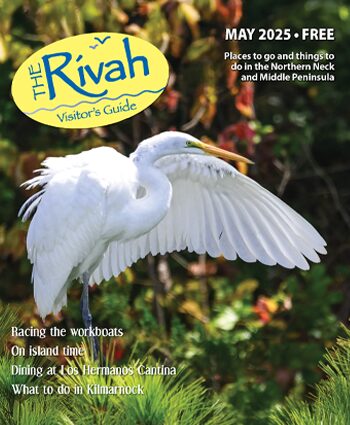It’s 4:15 a.m., the sky is in the transition from black to indigo still clad with stars, salt is in the air and a Tyler Childers tune is playing. Before any rooster can crow, Captain Cory Rice and First Mate Troy Ward of Northumberland are untying their lines from the pilings to head out of Hoskins Creek in Tappahannock into the Rappahannock River to fish their 250 crab pots.
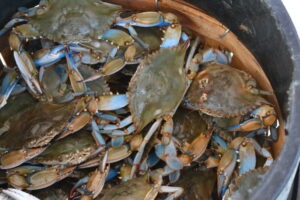
Because most July days climb into 90-something degrees by mid-morning, most crabbers, including Rice and Ward, get an early jump on the day with hopes to be off the water prior to noon.
Because Rice and Ward had spent the last several days traveling from Reedville to Tappahannock to crab, their alarms have been going off at 3 a.m., Rice said. He and Ward began the season crabbing the waters down in Hampton. After about five weeks, the duo moved their pots to Deltaville for about a month, then took on their backyard waters in Reedville for a bit.
“Nothing beats working in your own backyard,” Rice said when it comes to crabbing in Reedville.
The duo, who have been working with one another for a year now, said they will be playing it by ear to determine how long they will be setting and fishing pots in Tappahannock waters.
For both Rice and Ward, working on the water has been their bread and butter for the better part of their lives.
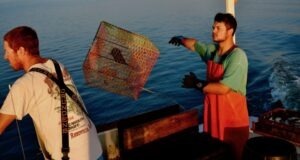
“I started culling crabs for my granddad when I was either five or six. I used to hate it back then, but look at me now,” Ward said with a chuckle and a grin.
Rice said he been crabbing part time on and off since the age of 12. After attending Virginia Tech for two years and working for Omega Protein for 11 years, he’s been working on the water full time for the past three years.
With several decades of combined experience, Rice and Ward have seen changes, shifts and patterns when it comes to how plentiful each season is and what impacts the potential results for their yields.
“It’s certainly been a bit slower than it was last year,” said Rice, comparing the seasons. “The only thing that’s helped is the market prices being higher. It’s not completely making up for the difference, but it’s helped,” he said.
The week of July 15, market prices for crabs per bushel were $234 for females, $328 for number two males, $335 for number one males, and $434 for jumbos, according to an associate with Jim Dan Dee Seafood.
According to the annual winter dredge survey conducted by Virginia and Maryland Chesapeake Bay scientists, juvenile crabs in the bay plunged by 30% this year. Despite the global shortage of crabs, Rice said he feels there is a promising outlook for weeks to come.
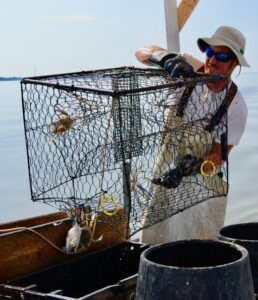
stinging nettles, too. “We’re in the land of stinging nettles and catfish,” said Rice.
With lines of buoys set as far as the eye can see, Rice and Ward use their years of cultivated skill to seamlessly hook, pull, shake, bait and throw their pots along the river.
As the duo approach their first line of pots just beyond the Downing Bridge, Ward is at the helm of the 25-foot vessel; he uses an extended hook to snag the first buoy. Once he successfully snags the buoy, he feeds the attached line to a pulley which aids in bringing up the pot. Rice then releases the old bait, opens the door to the pot, and shakes any crabs that have entered the pot into a shallow tub.
Rice then fills the pot with more bait, usually two to four bunker, and throws the pot back overboard.
With just a few seconds before reaching the next pot, Rice quickly culls the crabs from he pot he just shook, separating the females, number two males, number one males and jumbos into different bushel baskets.
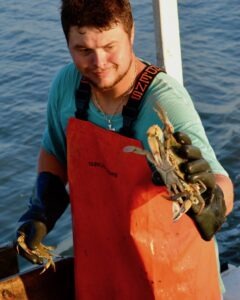
Ward and Rice repeat this process for 250 pots, with the two alternating who’s pulling and who’s shaking. “It’s all about the free throw! Gotta get the wrist action in there,” Ward said about his technique for throwing a freshly baited pot overboard.
While fishing the first line of pots, Rice said he was a bit disappointed in the lack of crabs each pot had yielded. With some pots coming up blank, the duo was holding out hope the further down river they traveled, the more plentiful the crabs.
When the 12th pot of the morning was pulled and Rice shook out about seven or eight hefty looking crabs, the duo was hopeful there would be many more pots just as bountiful.
“We need to see a few more like that,” Rice said.
After several hours of traveling the river and fishing their pots, the temperature was beginning to creep into the 90s and the wind would often disappear.
As the late morning was approaching, the duo finished their near six-hour day on the water and had pulled and reset each of their 250 pots.
Despite a slow and concerning start to the day, Rice said he was pleasantly surprised by how the day had finished. “We ended up finding the crabs somewhere I didn’t expect, so it’s been a promising day,” Rice said.
After crunching numbers in his head, Rice said they pulled in probably $175 more worth of crabs than they had the previous day.
The crabs that were caught that morning were hearty and hefty looking. Rice said the majority of crabs caught that day were number one males. Number one males typically range from 5 1/2 – 6 1/4 inches from point to point and are a heavier crab. Number twos usually come in at about 5-5 1/2 inches and are a bit less dense. Rice and Ward also brought in some jumbos and females for the day.
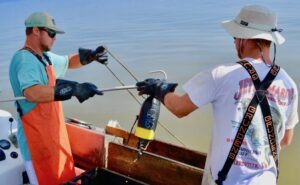
A bit past 10:30 a.m., the guys usually return to the dock and give the boat a quick clean. From there, they pack everything up and head to Reedville to sell the crabs to a wholesaler.
Despite early hours to rise and the potential for backbreaking days in the smoldering summer heat, it’s not hard to see why waterman like Rice and Ward have a clear love and dedication to their profession.
Each morning they are greeted by the rising sun on the river, casting a water color painted sky to serve as a backdrop for their “office.” Beyond the scenery, Ward still gets a rush when he pulls up or shakes the pots.
“My favorite part of it all is catching the crabs, it just gives you that rush, ya know,” Ward said.
Ward had spent the cold winter months counting down the days until he was back in the morning sun working the crabs.
While Rice agreed his favorite part of the job is also the actual catching of the crabs, he said his least favorite part is when they have to clean and bleach the pots.
Although both Rice and Ward have been oystering in the winter months, the upcoming season will mark the first year they will oyster together, making them a year-round team.
They agree that crabbing season is their favorite. Rice said you’re more accurately able to predict what each day is going to be like when it comes to oystering. Crabbing is more of an exciting gamble and requires learning how to utilize different strategies and techniques.
“There’s more potential to have a really good day on the water with crabbing,” Rice said.
Crabbing season begins in March and ends in November, which is when the two transition to crabbing every other day. They oyster on the off days.
Despite the developments that emerge, the tradition and authenticity of honest work on the water is maintained daily by watermen like Rice and Ward. Not only is their work laborious and intensive, it’s also a form of preservation to a timeless and classic Northern Neck and Chesapeake Bay tradition.


